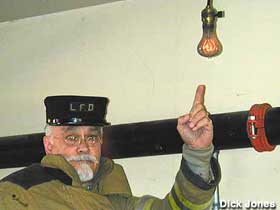
The light bulb in the Livermore Fire Department has been on for more than a century.
Light Bulb Methuselahs
"The light once lit shall never dim
But through all time shall honor him."
- Inscribed on the marble base of
"The Eternal Light" in New Jersey
An old light bulb may sound like an odd object of civic pride. But we admire steadiness, reliability, durability -- especially in turbulent times of hurly-burly and rickity-rack. When something as fragile as glass and hair-thin wire can keep doing its job, day after day, month after month, for over a hundred years, we are impressed -- especially when it seems as if every old-fashioned bulb nowadays burns out after only a couple of weeks. Why can't someone make an incandescent light bulb that lasts?
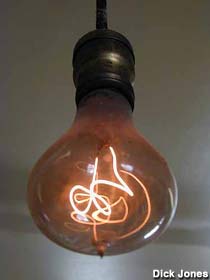
Livermore light bulb.
It turns out, someone has.
For years, the tour guides at the Thomas Edison Winter Estate in Fort Myers, Florida, awed visitors with a story of a light bulb, crafted by Edison himself, that had been burning there since 1886. It turns out that the story was just that -- a story -- spread and embellished over generations of seasonal help. The tour guides no longer make that claim, and the present management of the Estate would rather that everyone just forgot the whole thing.
There are other bulbs, however. And they are nearly as old, and they do still burn.
The cult of the oldest working light bulb flashed into prominence in 1970, when The Guinness Book of World Records listed a lamp in Forth Worth, Texas, as the world's "most durable." The Guinness Book, it turned out, was wrong, and it even gave the wrong age of the bulb that it honored. But its report had useful consequences. It spurred the backers of another ancient bulb, which hung in a fire station in Livermore, California, to begin investigating its history. They passed along what they found to Guinness, and Guinness, to its credit, changed its listing. In 1973 the Livermore lamp was crowned as the new champ -- the world's oldest known working light bulb -- and it has remained so ever since.
Exactly how old the bulb is, no one knows. Its most passionate supporter, the daughter of the man who gave it to the fire station, claimed that it was turned on in the summer of 1901 (Livermore arbitrarily celebrates its birthday on June 8). The lamp also might have been turned on in 1902, or possibly even as late as 1905. Even so, no other bulb currently claims to have been on the job for as long.
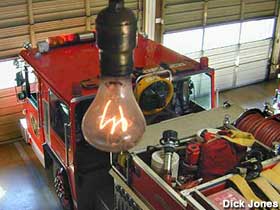
"The Centennial Light," as it's now known, still hangs 15 feet above the fire trucks in Station #6 on East Avenue. It has outlasted three previous fire stations, even though its original task -- enabling the firefighters to see the equipment at night -- has long since been passed to younger, more robust bulbs. It gives a faint glow, equal to about three candles, and it has almost never been turned off. These are the keys to its longevity. Bright bulbs burn out faster, and they almost always blow when you flick on the switch. If you used only 4-watt bulbs to light your home, and you had a dedicated power supply (as does The Centennial Light), your lamps might last a hundred years, too.
As dim as it may sound, the best way to keep a light bulb burning is to never turn it off.
In 2001, for the bulb's 100th birthday, Sandia National Laboratories -- a nearby nuclear bomb lab -- donated equipment and server space to create "BulbCam." The tiny camera, mounted next to the bulb, continues to provide a window for the world to see, every ten seconds, that Livermore's claim to fame is still in force.
The lamp that Livermore dethroned in the early 1970s is also still burning, and still in second place.
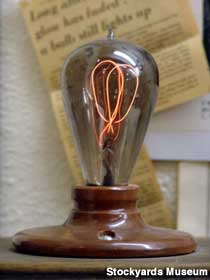
Fort Worth's "Eternal Light" still burns at the Stockyards Museum.
Known locally as "The Eternal Light," it spent most of its life hanging over a stage door entrance at Byers Opera House on 7th Street in Fort Worth, Texas. Thanks to careful record keeping by the opera house, the citizens of Fort Worth can prove that a stage hand named Barry Burke screwed in the bulb on September 21, 1908. The Opera House became a theater in the same year that the bulb was installed, then a movie theater in 1920. In 1970 someone accidentally turned off the bulb, which caused such a panic that the owner hung signs warning people away from the switch. The theater was torn down in 1977, but the bulb was saved and moved into a glass display case in the city's Stockyards Museum, plugged into an outlet, and continues to burn today.
Some may complain that The Eternal Light has been pampered for the last quarter-century -- a museum exhibit rather than a bulb with a job to do, hooked to a rheostat that gives it less than the usual amount of electricity to help prolong its life. But consider: for almost 70 years this bulb was no nightlight. "If it had to light that back stage door -- a dark area -- it had to burn bright," says Sarah Biles, the museum's administrator. In fact, it had to work twice as hard, as a companion bulb had burned out early and was never replaced. A hard-working light like that merits a little powering-down in its golden years.
Fort Worth's devotion to its bulb continues, in no way dimmed by its second-place standing. "We think that ours has a lot of personality, so it doesn't really bother us that there's one a little older," Biles explains. "We win the personality contest."
The story of the (formerly) third-oldest working light bulb is sad. The bulb reportedly was turned on in 1912, only four years after the one in Fort Worth, yet it received no accolades, no fame, no noble title, and ended its long life in obscurity. That was because it did not cast its light in a small town like Livermore, or even in a small city like Fort Worth. It glowed in the heart of midtown Manhattan, where few paid attention to the feeble light of an old bulb.
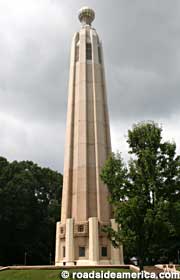
Light Bulb on the Edison Tower, Edison, NJ.
One man did. His name was Jack Gasnick. The bulb hung over the back door of his business, Gasnick Supply, a hardware store on Second Avenue between 52nd and 53rd Streets. Jack loved his bulb, and hated the one in Livermore. In 1981 he wrote to Dear Abby and claimed that the Livermore bulb had burned out. (It hadn't.) In 1983 he wrote to Guinness and claimed that the Livermore bulb was a fraud. From what he could see of the bulb -- and he spoke as a trained mechanical engineer -- the socket seemed all wrong, and there was no carbon deposit on the inside of the glass. (Gasnick noted that his own ancient bulb was filthy.) Since the Livermore bulb's authenticity was suspect, Gasnick declared that his bulb -- whose age he said that he could verify -- was the world's oldest. Jack evidently did not know about The Eternal Light in Forth Worth.
What happened to the Gasnick lamp, no one knows. Gasnick, perhaps frustrated that his bulb was not winning the recognition that he felt that it deserved, sold the business, retired, and disappeared. The store, and the entire half-block on which it stood, was blown away in 2003 to make room for a 31-story tower of million-dollar condominiums. Did Gasnick take his bulb with him -- or was it still burning when the power was cut off and the wrecking ball arrived? It was a tough old bulb; who knows? Perhaps it lies buried under tons of rubble, patiently waiting for some future civilization to dig it up and screw it into a working socket.
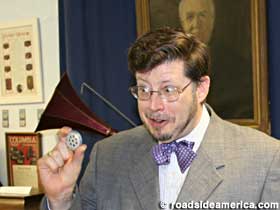
Menlo Park Museum curator Jack Stanley explains a non-light bulb-related invention of Thomas Alva Edison.
Just across the Hudson River from Gasnick's is another Eternal Light. This one was even more famous in its time than the one in Fort Worth. It is enshrined in the rotunda of The Thomas Edison Memorial Tower, a 131-foot-tall Art Deco spire in Metuchen, New Jersey, which is topped by another famous lamp, "The World's Largest Light Bulb" (a bulb-shaped, illuminated Pyrex dome).
The Eternal Light bulb, unlike its humble, long-lived rivals, was expected to last forever. It was turned on by Thomas Edison himself, on October 21, 1929, one of the many highlights of the Light's Golden Jubilee celebrations orchestrated by PR god Edward Bernays for the General Electric Company. The jubilation, however, didn't last. Edison was dead two years after he flicked the switch. Six years after that the Tower fell down. The light bulb miraculously survived the collapse and -- even more miraculously -- it never went out.
Or at least that's what General Electric claimed. Company spokesmen (and compliant local newspapermen) reported that the light continued to burn while a second tower, the one standing today, was built around it. The light was, after all, eternal.
When we visited The Eternal Light in the 1990s it was glowing feebly in the otherwise gloomy and unlit Tower rotunda, upright, under a dusty glass dome, set into an impressive marble base. It didn't appear to have a filament, which meant that its light was produced by -- well, frankly, we didn't know. A sign nearby referred to it as a "highly exhausted bulb," which seemed true enough. Its energy appeared nearly spent. We were concerned. Would the final flicker of an eternal light signal the arrival of the End Times?
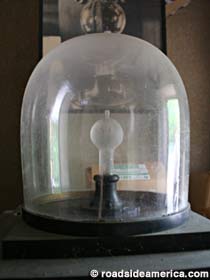
The "highly exhausted bulb" in the Thomas Edison Memorial, Edison, NJ.
Jack Stanley, who was then the curator of the Menlo Park Museum next door to the bulb (and the caretaker of the Tower), was not worried. "'The Eternal Light' is neither," he explained. "It's not eternal, and it's not a light bulb."
When Stanley took over the place in 2003, his first priority was to close the tower. "Cement has a lifespan," he said. Although the tower was not in danger of collapsing like its predecessor, its outside panels were crumbling. Stanley estimated that it would take $3 to $4 million to fix up the place (It was scheduled to reopen to the public in 2014), so that visitors can again enter the rotunda to see -- a fraud. A flim-flam. When Stanley opened the marble base of The Eternal Light, he discovered that the bulb was hollow, and connected to a tube. Behind a cardboard panel he found the source of the lamp's illumination: four automobile headlights, pointing up into it.
When we visited ten years ago, the bulb was evidently down to its last headlight.
"I call it 'The Nocturnal Light' now," Stanley said, "Because it's been out for a while."
Another old lamp that was worthy of recognition -- at least until it burned out in December 2019 --also shed some light on what Livermore and Forth Worth must have been like before their bulbs became famous. It was in a fire station, built in 1912, in the prairie town of Mangum, Oklahoma. Mangum felt no need to measure itself against others, and was content to keep its bulb to itself. There were no webcams, no glass display cases. The bulb didn't even have a name. Locals referred to it simply as "The Bulb."
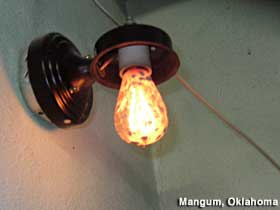
Mangum Oklahoma light bulb.
No one knows for sure when The Bulb was turned on. Best guesses range from 1926 to 1929, with most folks favoring the more recent years. "When you put a light bulb in, you don't typically give it much thought," explained Louise Price, the former city manager.
The bulb had attracted local attention as early as the 1940s, as the others around it flickered and died while it kept glowing. It was moved to a corner of the upstairs dormitory in the 1960s, and for a time the firefighters covered it with black paint so that they could sleep. (A shade later served that purpose.) There was no separate electricity supply, no rheostat to smooth out power surges. When the juice went off, the bulb went off; when it came back on, the bulb did too. A big storm in 1994 shut off electricity for a week, but afterward the old light roared back to life just like all the others.
Mangum is a mere 200 miles northwest of Fort Worth and its Eternal Light. This meant that the interested traveler could see two of the world's oldest working light bulbs in one day on a single tank of gas.
To recap:
- Livermore, CA (turned on 1901-1905)
- Forth Worth, TX (turned on 1908)
- Mangum, OK (turned on 1926-1929, burned out 2019)
The gap between numbers two and three invites speculation. There surely must be other old bulbs out there, burning in obscurity, known only to a relatively small circle of local fans. The lack of Methuselahs east of the Mississippi, where one would expect the oldest lamps to be, just doesn't seem right.
So why not look around your neighborhood? Is there an old theater, or firehouse, or hospital, or library with a light that's always on? It could be a bulb for the record books. All you have to do is to find someone old enough to remember when it was plugged in.




